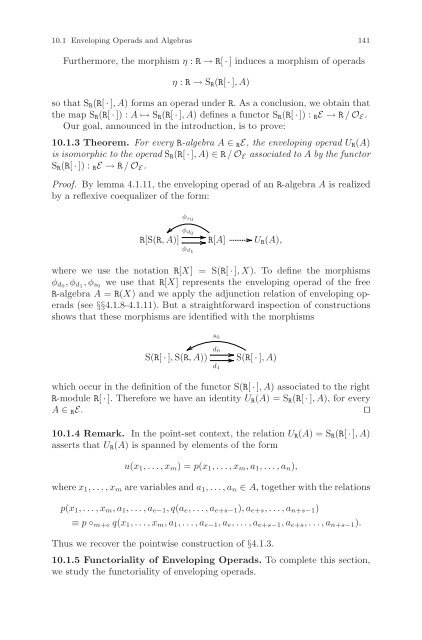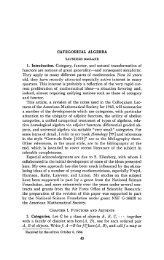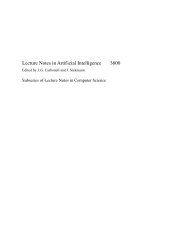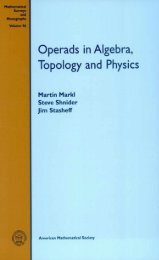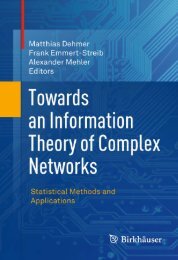Symmetric Monoidal Categories for Operads - Index of
Symmetric Monoidal Categories for Operads - Index of
Symmetric Monoidal Categories for Operads - Index of
Create successful ePaper yourself
Turn your PDF publications into a flip-book with our unique Google optimized e-Paper software.
10.1 Enveloping <strong>Operads</strong> and Algebras 141<br />
Furthermore, the morphism η : R → R[ · ] induces a morphism <strong>of</strong> operads<br />
η : R → SR(R[ · ],A)<br />
so that SR(R[ · ],A) <strong>for</strong>ms an operad under R. As a conclusion, we obtain that<br />
the map SR(R[ · ]) : A ↦→ SR(R[ · ],A) defines a functor SR(R[ · ]) : RE →R / OE.<br />
Our goal, announced in the introduction, is to prove:<br />
10.1.3 Theorem. For every R-algebra A ∈ RE, the enveloping operad UR(A)<br />
is isomorphic to the operad SR(R[ · ],A) ∈ R / OE associated to A by the functor<br />
SR(R[ · ]) : RE →R / OE.<br />
Pro<strong>of</strong>. By lemma 4.1.11, the enveloping operad <strong>of</strong> an R-algebra A is realized<br />
by a reflexive coequalizer <strong>of</strong> the <strong>for</strong>m:<br />
R[S(R,A)]<br />
φs 0<br />
φd 0<br />
φd 1<br />
R[A]<br />
UR(A),<br />
where we use the notation R[X] = S(R[ · ],X). To define the morphisms<br />
φd0,φd1,φs0 we use that R[X] represents the enveloping operad <strong>of</strong> the free<br />
R-algebra A = R(X) and we apply the adjunction relation <strong>of</strong> enveloping operads<br />
(see §§4.1.8-4.1.11). But a straight<strong>for</strong>ward inspection <strong>of</strong> constructions<br />
shows that these morphisms are identified with the morphisms<br />
s0<br />
S(R[ · ], S(R,A)) d0<br />
d1<br />
S(R[ · ],A)<br />
which occur in the definition <strong>of</strong> the functor S(R[ · ],A) associated to the right<br />
R-module R[ · ]. There<strong>for</strong>e we have an identity UR(A) =SR(R[ · ],A), <strong>for</strong> every<br />
A ∈ RE. ⊓⊔<br />
10.1.4 Remark. In the point-set context, the relation UR(A) =SR(R[ · ],A)<br />
asserts that UR(A) is spanned by elements <strong>of</strong> the <strong>for</strong>m<br />
u(x1,...,xm) =p(x1,...,xm,a1,...,an),<br />
where x1,...,xm are variables and a1,...,an ∈ A, together with the relations<br />
p(x1,...,xm,a1,...,ae−1,q(ae,...,ae+s−1),ae+s,...,an+s−1)<br />
≡ p ◦m+e q(x1,...,xm,a1,...,ae−1,ae,...,ae+s−1,ae+s,...,an+s−1).<br />
Thus we recover the pointwise construction <strong>of</strong> §4.1.3.<br />
10.1.5 Functoriality <strong>of</strong> Enveloping <strong>Operads</strong>. To complete this section,<br />
we study the functoriality <strong>of</strong> enveloping operads.


